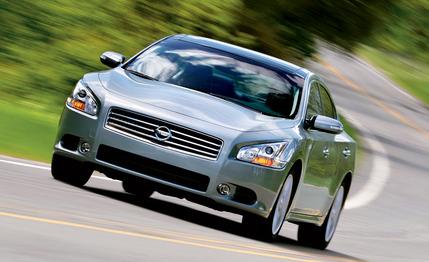 Road Test
Road Test
The Maxima belongs to a threatened species, the front-drive sporting sedan. No one is talking extinction here, but rear drive allows a balance of handling and a purity of steering that’s just not possible in a front-driver with upwards of 270 horsepower. So, over the last, say, dozen years, the popularity of rear-drivers from Benz, BMW, Cadillac (CTS), Infiniti, and Lexus—not to mention Mustangs, and 300s, Magnums, and Challengers from Chrysler—have bled away the excitement from the front-drive class.
Now comes an all-new Maxima with a distinctive, hourglass shape and plenty of motor muscle, but it’s still a front-driver. Where shall we park it in the new-car pantheon?
Over by the Acura TL, for sure, along with the VW Passat, perhaps. The Maxima’s opening price within a shallow breath of $30,000 puts it lower than most of the famous-maker European imports, and its lack of a manual gearbox damps its appeal to the red-hot-corpuscle crowd. Actual sporting flavor comes down to a single option, which we’ll cover below in more detail. Without that, the Maxima is merely the top-line four-door available in Nissan stores.
This new car, chopped nearly four inches in length compared with the previous model, has been moved to Nissan’s all-purpose D platform, also used for the Altima and Murano. The Maxima is notably wider than the Altima, 2.5 inches overall on a track that’s up by 1.5 inches in front and 1.6 in back, but other dimensions are within an inch on both. Inside spaces, except for more shoulder width on the Maxima, are similar within an inch, too, and the Maxima’s total interior volume is five percent smaller than the Altima’s.
Nissan found a new look for this car, with a simplified grille shape compared with its other models. The way the fenders flare wide around the wheels reminds of Seventies-era IMSA racers. In the wind tunnel, air flowing over the new surfaces shows its disapproval, with a drag coefficient of 0.33.
There are zero powertrain options. Nissan’s lusty 3.5-liter V-6 is standard, backed by a CVT. Output is 290 horsepower, up 35 from that of the 2008 Maxima, with a 6600-rpm redline. If you get some enjoyment from the idea of a transmission that’s never caught with the wrong ratio, you’ll delight in the CVT. On most calls for acceleration, the revs smoothly zoom up in proportion to thrust; there’s never a harsh downshift. Nissan’s way with a CVT tops all other makers, we think.
New for 2009 is the “drive sport” shifter calibration, which opens a complex discussion of the options menu. In the base Maxima, indicated by an “S” in the literature, or the step-up SV model—neither is badged on the car—you move the console shifter to the left into the manual mode, which engages software that maintains engine revs during cornering and holds a racy ratio on exit. If you order the SV with either the Premium or the Sport package—these designations are not physically indicated on the car, either—you get large shifter paddles above and below the horizontal steering-wheel spokes to do the same thing without moving your hands from the wheel.
This is a peppy performer, sprinting to 60 mph in 5.8 seconds, continuing on to finish the quarter in 14.5 seconds at 98 mph.
The standard tire for both S and SV is a 245/45R-18. The Goodyear Eagle RS-A all-weathers on the test car gripped sufficiently to achieve 0.85 g on the skidpad and stop from 70 mph in 175 feet. These are generally quiet tires with good masking of small-bump harshness and very little tread noise. In other words, they’re not overtly sporty and won’t annoy an owner who just wanted a nice car with a touch of upmarket panache.
The Maxima line starts with the S, at $29,950, which should account for about 10 percent of sales. You get cloth seats but leather on the wheel and shifter, blue-dots-on-black trim panels on the dash and console, smart-key entry, a sunroof, dual-zone climate control, and all of the safety equipment, including front and side airbags for front occupants and side curtains in front and back. Stability control, traction control, and tire-pressure monitoring are standard, as they are with most cars these days.